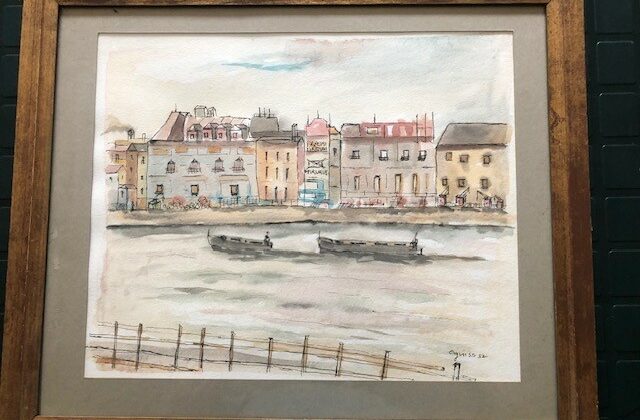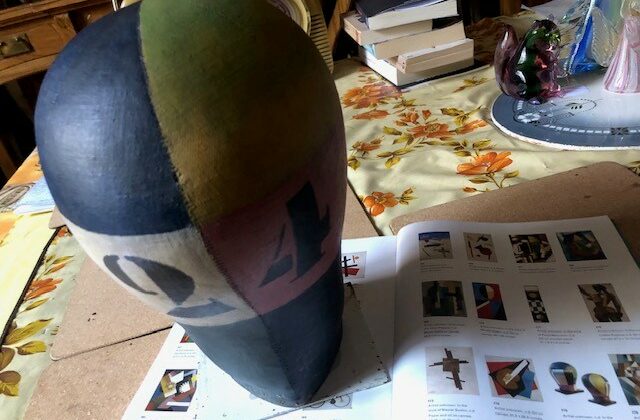Sonia Delaunay. A life as avant-garde, in collaboration with husband, working till forces and voice permitted
Sonia Delaunay
Tate Modern
By Prof. Francesco Carelli, Milan
Sonia Delaunay (1885–1979) was a key figure in the Parisian avant-garde, spanning in painting, fashion and design. Tate Modern presents the first UK retrospective of her extraordinary artistic career, from her early figurative painting in the 1900s to her energetic abstract work in the 1960s. This exhibition offers a radical reassessment of Delaunay’s importance as an artist, showcasing her originality and creativity across the twentieth century.
Her work expressed the energy of modern urban life, celebrating the birth of electric street lighting and the excitement of contemporary ballets and ballrooms.
The artist dedicated her life to experimenting with colour ( vivid colours ) and abstraction, bringing her ideas off the canvas and into the world through tapestry, textiles, mosaic and fashion. Delaunay premiered her first ‘simultaneous dress’ of bright patchwork colours in 1913 and opened a boutique in Madrid in 1918. Her Atelier Simultané in Paris went on to produce radical and progressive designs for scarves, umbrellas, hats, shoes and swimming costumes throughout the 1920s and 1930s. Clients included the Hollywood star Gloria Swanson and the architect Erno Goldfinger, as well department stores like Metz & Co and Liberty.
The diverse inspirations behind Delaunay’s work travel from the highly personal approach to colour which harked back to her childhood in Russia, to the impact of her years in Spain and Portugal where she painted The Orange Seller 1915 and Flamenco Singers 1915-16.
For the 1937 International Exposition in Paris, she created vast seven – metre murals Motor, Dashboard and Propeller.
Following her husband’s death in 1941, Sonia Delaunay’s work took on more formal freedom, including rhythmic compositions in angular forms and harlequin colors, which in turn inspired geometric tapestries, carpets and mosaics. Delaunay continued to experiment with abstraction in the post-war era, just as she had done since its birth in the 1910s, becoming a champion for a new generation of artists and an inspiring figure for creative practitioners to this day.
A world of colour would be ideal, where one could create emotions accordingly. We could live by impressions the way a blind man lives by touch. We could vivify or seduce, transmute or emote, the possibilities are endless. A world of color so fine and pure, from the deepest innermost part of the human body to the pale washed evasiveness of the white of the human eye. We could live in a constant state of aura where every feeling manifested itself by color thus removing the lie from mankind.
Sonia Delaunay took an early, perhaps the earliest jump into non-objectivity where color elicited form. Her work shows tenacious intensity with which she threw herself into her art, her life. She lived a philosophy of emotion; delving, gouging, tasting, creating. Through a direct communication with the gut, she relied on intuition rather than intelligence, as did men of stature such as Goethe. She strived to emulate such greatness.
Sonia Delaunay entered so far inside as to reach the womb. She returned not only to primitive sensibility in terms of the universal, but also in terms of woman, of motherhood. As early as 1911, Delaunay delved into the non-objective world. Remembering the peasant crafts of her native Russia, she juxtaposed pieces of fabric and fur to create a lyrical, one-dimensional assemblage of semi-geometric shapes; a primary research into the world of color which was to dominate and dictate the theme of her life. Color became her leitmotif.
She erected a scaffolding of new impressions to reach not upward but inward. A new language of feeling corresponding to the Futurist movement in Italy, Constructivist in Russia, Blaue Reiter in Germany. Sonia Delaunay is at the root of modern art.
She was no theoretician, thus she sought refuge in a more earthy medium. She applied her and her husband’s ideas of the “Simultaneous” and “Pure Painting” to a lamp shade of which she gave the name “Halo Depth;” curtains, “Depth Movement;” cushions, “Sec Movement Colors Depth,” “Astral;” goblets, “Moon Absinthe,” “Water Wine,” “Wine.”
She had already been involved herself in what one may call her Fauve period. Although she disliked Matisse, she was influenced by his transformation of the banal to the vivified via color. From Gauguin, she took the organization of flat colored surfaces. And from Van Gogh, the intensity of color. Although her paintings from this period are colorful, they are far from being “light.” In fact one can trace the somber quality of intent studies, through her concept of depth being the inspiration for “pure painting.”
Married to Robert Delaunay, together they worked, collaborated, exchanged. The richness is legendary. Every night they walked along the Boulevard St. Michel where the gas lamps had just been replaced by electricity. They would return home and capture their impressions of color, much the way Monet did, but in a new and different mode. A non-objective one. Together they walked to the Eiffel Tower, an edifice Robert believed to be the paragon of technology. In honor of their love, he did a small painting of the tower with an inscription on one side reading: “Exposition Universelle…1889 La Tour a l’Universe J’adresse,” and on the other: ” Mouvement Profondeur 1909 France-Russie.”
1911–1912 marks the beginning of abstract art, the beginning of the Delaunay’s experiments with color. Sonia had just begun when she encountered the poetry of Blaise Cendrars. Its movement and association conjured further images of her rhythmic forms and her art was propagated. She made a book binding for his work and stated: “Painting is a form of poetry, colors are words, their relations rhythms, the completed painting a completed poem.” She collaborated much with Cendrars and later made bindings for the works of Rimbaud, Walden, Apollinaire, Tzara, Mallarme…
On the rue des Grand Augustins, the Delaunays held court. To their Thursday evening salons came Apollinaire, Jean and Sophie Taeuber Arp, painters, poets, musicians of the day. Groups would go together afterwards to the Bal Ballier in Montparnasse, a popular dance hall where the Tango and the Fox Trot were the rage. As early as 1912, Sonia Delaunay decorated her clothes with geometry and color, freeing herself from flowers and frills. One may even call her the predecessor of art deco. Apollinaire wrote the following about her and her husband’s ensembles: “They do not burden themselves with the imitation of antiquated fashion, and since they want to be of their own time, they don’t innovate in the cut of cloth (in that they follow contemporary fashion), but rather they seek to influence it by employing new fabrics, infinitely varied with color. There is, for example, an outfit of M. Robert Delaunay: purple jacket, beige vest, black trousers. Here is another: red coat, with a blue collar, red socks, yellow and black shoes, black trousers, green jacket, sky-blue vest, tiny red tie…” About Sonia Delauney: “…purple dress, wide purple and green sash, and, under the jacket, a corsage divided into brightly colored zones, delicate or faded, where there is mixed an old rose, yellow-orange color, Nattier blue, scarlet, et cetera…appearing on different materials, so that wool cloth, taffeta, tulle, flannelette, watered silk, and peau de sale are juxtaposed…So much variety cannot escape notice. It transforms fantasy into elegance…”
That fantastic elegance made its way through World War I to the “Exposition des Art Decoratifs” in Paris, 1925. Sonia Delaunay’s collaboration with Jacques Heim celebrated her worldwide. Furs, automobiles, furniture, clothes, bags…nothing was out of her reach. She also did costumes, those for Diaghilev remain among the Ballet Russe’s best. Cleopatra was swathed in circles stemming from the breast, giving costume the illusion of dance, the airy, ethereal step into another dimension. One critic said the dancers “set in motion costumes that already simulated motion…”
The work by husband and wife continued earnestly. The exchange, the inspiration, collaboration. The marriage of the Delaunays remains today the most magical artistic merger. In 1941, Robert met an untimely death. With World War II, and Robert’s death, Sonia began to incorporate the color black into her work. She realized then that there are as many shades and textures of black as there are colors. Her work was interrupted when she devoted ten years of her life to preserving her husband’s legend.
She died at 93. She worked until 90 but has been arrested by failing health. She fell and has been immobile for long time. Her apartment in St. Germain des Pres was white and light filled. Ceilings soared harboring enormous tropical plants. There were works by her and her husband, and gifts from Jean Arp, Henri Laurens, Hans Hartung, and others. The spirit of Sonia Delaunay was everywhere: on the floor in rugs, in a myriad of books and posters, catalogues, sketches, paintings. Sonia Delaunay, was white on white: white hair with a cream complexion, few wrinkles and a prevailing sense of softness.
Acknowledgments to Tate Modern offices for their usual kindness on information and open use on their concrete and short material and introductive part.




